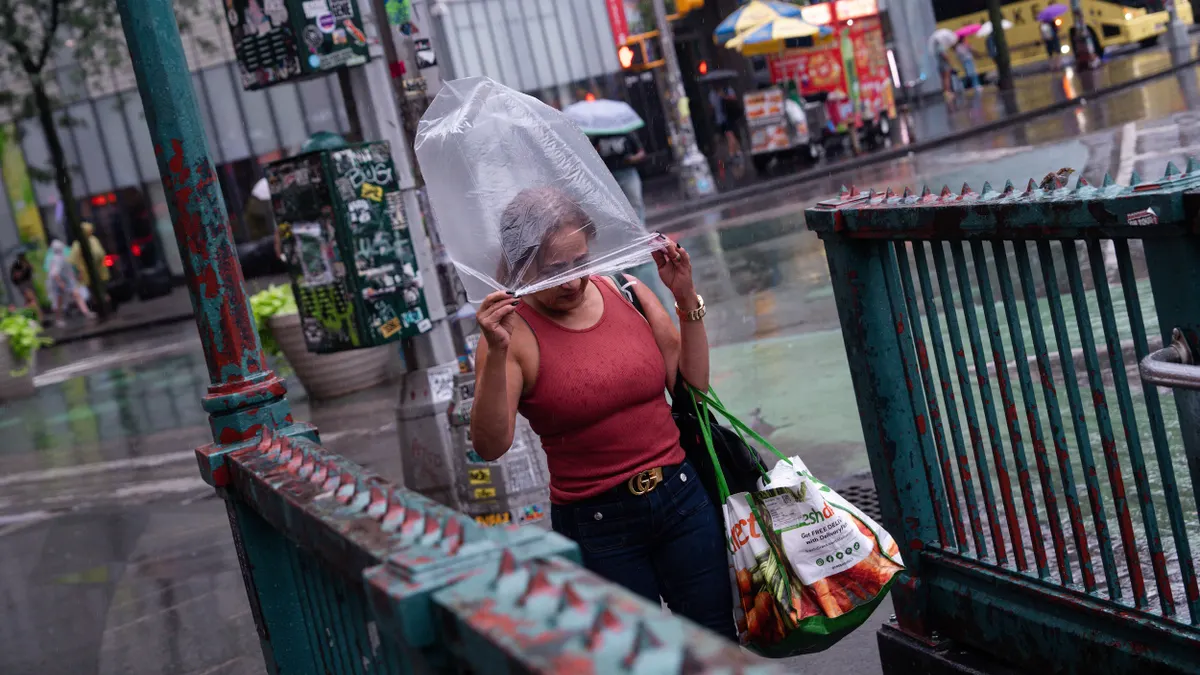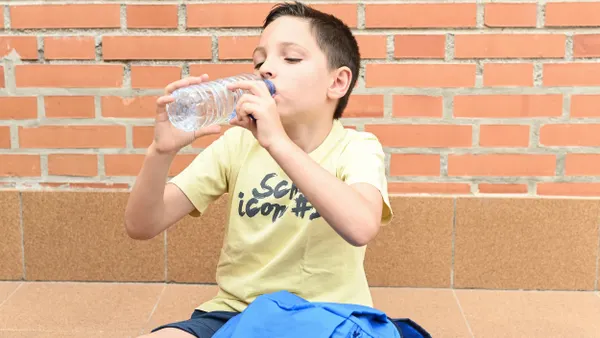The pandemic hushed the anticipated roar of cheering fans at Wrigley Field for the Chicago Cubs’ home opener, scheduled for March 30. But two weeks later, different pandemic-induced sounds began echoing through the historic stadium: zooming forklifts, the beeping of delivery trucks and the shuffle of cardboard whirring down a temporary conveyor line as volunteers filled donation boxes with food.
The pandemic caused an abrupt spike in food assistance requests in Chicago — a 400% increase at peak — so the city's Lakeview Pantry sought a solution to meet demand while simultaneously ensuring volunteers could socially distance. The Cubs provided temporary use of the stadium for expanded food packing and distribution until the baseball season resumed in July.
The satellite site allowed Lakeview Pantry staff and volunteers to pack about 1,200 food distribution boxes daily, six days a week, serving 2.5 million pounds of food to more than 60,000 individuals during the site’s three months in operation, according to a Lakeview Pantry spokesperson. The organization also added hours to its other locations, expanded its home delivery program for the elderly and expanded its mental health counseling services.
This is only one of the many hunger mitigation measures that unfolded when the pandemic struck — and Chicago is hardly the only city where food insecurity skyrocketed. Cities of all sizes around the world felt the pressure as economies shut down and social safety nets became insufficient under the pressure of new individuals who were unable to access food.
Cities and organizations are grappling with implementing immediate, short-term programs to safely feed people, while determining how to parlay the initiatives into long-term measures as the pandemic and its repercussions drag on.
A sudden, 'unprecedented' surge
The United Nations estimated in June that the pandemic could cause the number of undernourished people globally to increase by up to 132 million in 2020 alone. And research from Northwestern University indicated that overall food insecurity in the U.S. doubled in April relative to predictions, and tripled for households with children.
Lockdowns and widespread job losses play a huge role in the sudden rise of food insecurity, an increase that several sources have called "unprecedented." Food supply chain disruptions, rapidly rising grocery prices and the recent end of the federal government's $600-per-week unemployment benefits supplement also are contributing factors to the increase in hunger.
Though many cities see food insecurity growing in nearly every neighborhood, it does not necessarily grow evenly. Areas that already were poverty-stricken or considered food deserts have become hotbeds for additional food assistance requests during the pandemic, said Kathryn Garcia, commissioner of the New York City Department of Sanitation and the city's COVID-19 food czar. These same low-income neighborhoods, predominantly inhabited by people of color, also are experiencing disproportionately higher numbers of COVID-19 cases.
Many cities have seen demand for food assistance come in waves over the last five months, much like the virus itself. In New York, demand has been relatively steady from the start, Garcia said, but noted the correlation between areas hit hard early by the pandemic and rising food assistance needs.
The influx of demand in food assistance, particularly from some individuals who have never dealt with that problem, is creating a new challenge for cities and nonprofits: customer embarrassment. Many local governments and food assistance organizations are working to ensure that all residents know about the available relief and are encouraged to seek it out.
"For some people it's new, embarrassing or shameful. It doesn't have to be that way,” said Eddy Badrina, CEO of Eden Green Technology, a vertical hydroponic greenhouse business donating produce grown at its facility during the pandemic. "People are more willing to raise their hands than to ask for help, so we need to be the ones asking: Who needs help? The response you get when you act proactively is night and day."
The hesitance to accept aid often dissipates quickly in areas more acutely affected by the virus, as New York was earlier this year. "I feel like there was less embarrassment than there might have been because… it got so bleak here that everyone felt like they were in the same boat," Garcia said.
Cities scramble for solutions
Schools were among the first institutions to close during the pandemic, and therefore children from low-income families who rely on school breakfast and lunch programs lost a major — and in some cases, their only — form of sustenance. Cities including Chicago, Los Angeles, Milwaukee, Pittsburgh and Seattle established free to-go food programs for students in need.
Some school districts are also serving non-school age children and offering multiple days' worth of food to reduce how often children trek to pick-up sites. New York decided to allow anyone who showed up at school distribution sites to receive food.
"That was a whole new paradigm for how school food distribution operated," Garcia said. "We were very concerned about anyone going hungry."
Traditional food assistance facilities like soup kitchens are not designed for socially distanced service, therefore aid groups must figure out creative solutions to feed residents, Garcia said.
Pop-up food distribution sites and home delivery are two programs that have become popular across the country. New York started pop-up pantries in neighborhoods with food access gaps and set up "an entirely new infrastructure system" for food delivery to seniors and homebound individuals, Garcia said. As of early August, more than 120 million meals had been delivered, and the program continues to run.
Overall, pandemic food distribution "has been a Herculean effort across many agencies: writing the contracts, staffing food hubs, preparing meals for students, loading taxis with food for delivery. It’s been an all-hands-on-deck approach to ensure people don't go hungry during the pandemic," Garcia said.
In NYC everyone can get food from their culture without a hitch - & yesterday was one example.
— NYC Sanitation (@NYCSanitation) July 24, 2020
With #Latinx food donated by a #Bronx supplier, Commissioner Garcia & CM @Salamancajr80 gave out food to residents including #plantains and pineapples. pic.twitter.com/0L5S2m3vsC
In March, the Jacksonville, FL Mayor’s Office of Strategic Partnerships launched its COVID-19 Food Delivery Task Force to ensure existing food delivery partners were adhering to the Centers for Disease Control and Prevention’s health guidelines. Public, private and philanthropic task force members also collaborated to assess food resource inventory and distribution plans.
"Many new and innovative partnerships developed, resulting in more customer-centric methods of food distribution," said Dawn Lockhart, City of Jacksonville's director of strategic partnerships, in an email.
One of the city’s main collaborations is with the Jacksonville Transportation Authority (JTA), the Jacksonville Housing Authority and FarmShare, in which JTA vehicles deliver food to residents' homes. Jacksonville also transitioned its senior-center based meal program to a combination of pick-up and home delivery.
Meanwhile, Seattle's King County, WA recently took action to address hunger, approving in July a $4.83 million food security assistance program to address increased demand. The program will provide options of culturally appropriate foods that recipients might not have access to through usual avenues.
"The ordinance is also clear that the food security assistance program will address those historically disadvantaged communities that have been disproportionately impacted by inequities and discrimination," said a county spokesperson via email.
The county is accepting applications for projects such as food vouchers and increasing infrastructure capacity, and aims to have the program running in late September.
Help from the outside
With many city governments lacking adequate resources to meet the influx in demand for food assistance, businesses and organizations across the country are contributing financially to help food relief efforts or setting up direct food assistance programs.
Nonprofit organization World Central Kitchen (WCK) is partnering with thousands of restaurants to simultaneously fight hunger and get laid-off service sector employees back to work. While the organization typically provides meals to people affected by natural disasters, WCK transitioned much of its attention to distributing fresh meals to children and families and delivering to people isolated in their homes. Thus far, WCK has provided restaurants with $90 million for 25 million meals in 400 cities.
How do we plate up 3,600 dishes of meatballs at @Nationals Park in Washington, DC? An incredible & dedicated team! ???? To date, WCK's Relief Team has delivered nearly 800,000 nourishing meals from this kitchen as well as several hundred thousand from local restaurants. pic.twitter.com/RLqSqGJVO0
— World Central Kitchen (@WCKitchen) August 13, 2020
At Eden Green Technology, the company's long-term vision was to implement sustainable and nutritious changes to the way produce is farmed and how people eat. The pandemic created another opportunity to further the mission by filling gaps in people's access to healthy foods, as opposed to non-nutritious pre-packaged foods.
"Very early in the pandemic we understood that we were going to come upon food shortages. Not from a lack of food, but from an inconsistent and interrupted food supply chain," Badrina said. The company eased local supply chain issues by donating the greens and other vegetables that it grows for case studies at its research and development facility, to local food banks and shelters in the Dallas-Ft. Worth area.
Eden Green also partnered with a local microfarm that supplied restaurants with fresh foods until the pandemic forced restaurant closures. The farm owner pivoted to creating home delivery food kits to stay afloat, and Eden Green agreed to donate one pound of fresh produce to a local nonprofit for every new customer that signed up for the food kits.
Simultaneously helping a local entrepreneur and people who are hungry has been a strong draw for new customers, Badrina said. "That's a prime example of thinking strategically ... If more companies did that, I think it would go a long way with meeting the needs of our community."
Urban agriculture initiatives are also helping to feed community members. In Los Angeles, groups organized a fruit-share program in which hundreds of residents volunteered to leave out boxes of free produce from their fruit-bearing trees.
Meanwhile, the Adrienne Arsht-Rockefeller Foundation Resilience Center opened its first community resilience pod to help Miami-Dade County residents suffering from food insecurity. The center distributes thousands of food boxes, fruit trees and potted kitchen gardens with information to help people boost their resilience by planting their own food-bearing plants.
And in Atlanta, the Food Forest at Browns Mill, established last year, is proving to be a worthwhile investment. While many plants, such as fruit trees, are still in the process of being planted or reaching their food-bearing state, others including berries, herbs and the vegetable garden are producing nutritious, fresh food for the community.
Most of this food last year went to volunteers, with the excess donated to local senior centers. This year, the pandemic altered the modes of distribution, said food forest ranger Mike McCord. People are now encouraged to arrive at the food forest at certain times of day to receive a bag of fresh food. The group also started a delivery service for residents with mobility issues or who are homebound for health reasons.
Keeping momentum
The pandemic brings a plethora of uncertainty around the health of Americans and the economy, with most cities facing budgetary constraints that could threaten efforts around food insecurity mitigation. Despite these intense challenges, the situation is an opportunity for cities to rethink how to fight widespread hunger, both now and in the future, Garcia said.
For example, cities can assess best practices from the current emergency food assistance programs in developing new structures to serve large populations experiencing hunger. The situation could also draw attention to how best to serve specific populations that may suddenly become disproportionately affected by hardship, such as older individuals.
Beyond the pandemic, the current attention to food insecurity might attract more support for everyday hunger mitigation initiatives in the future.
"Philanthropic organizations do a lot of emergency food assistance in the world, but not a lot of people traditionally fund hunger programs ... They assume people can rely on food stamps and that will be enough, but it’s not," Garcia said. "I think we need to look at that and think about the challenge of hunger much more widely."



















